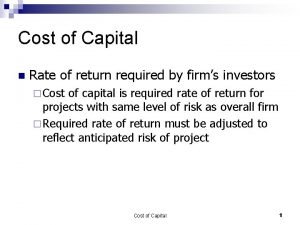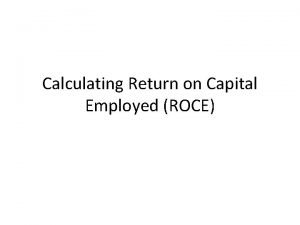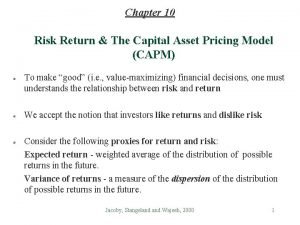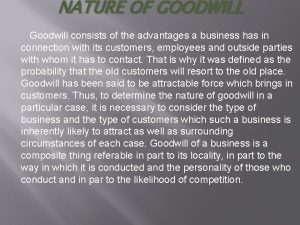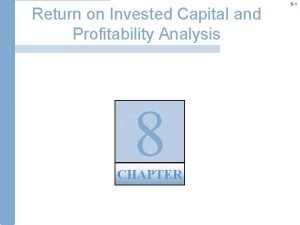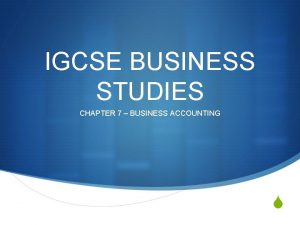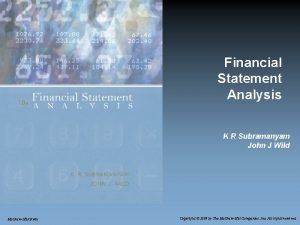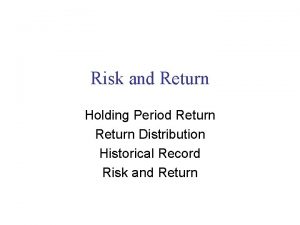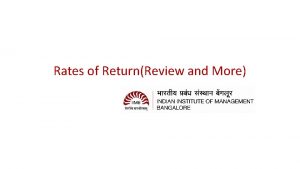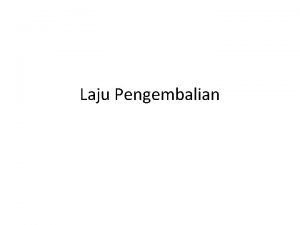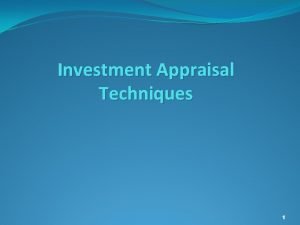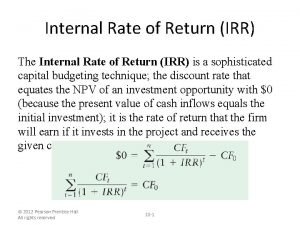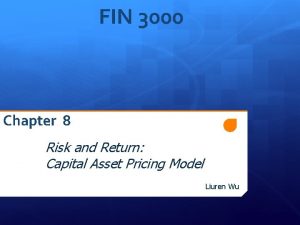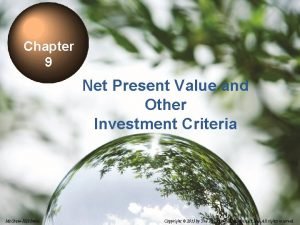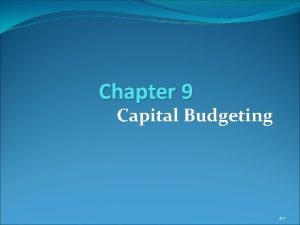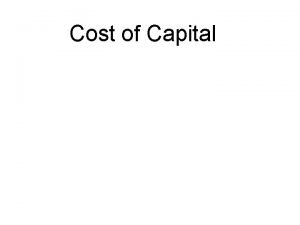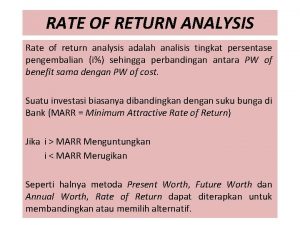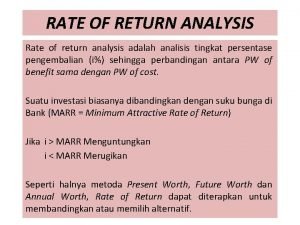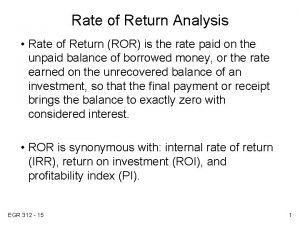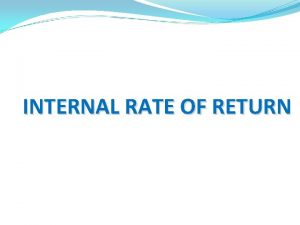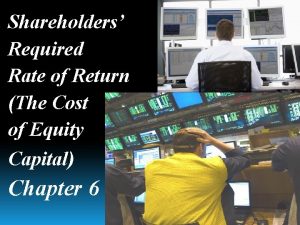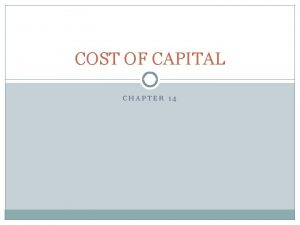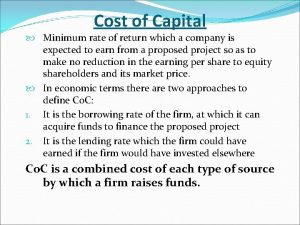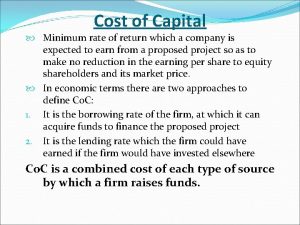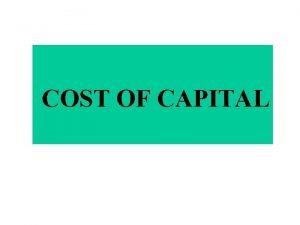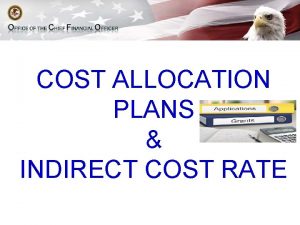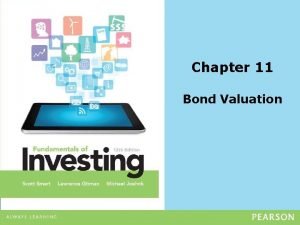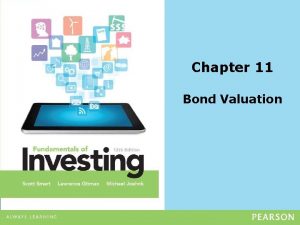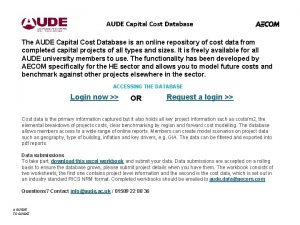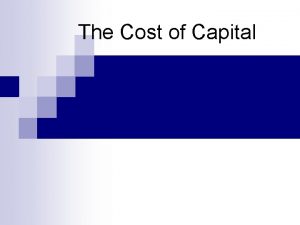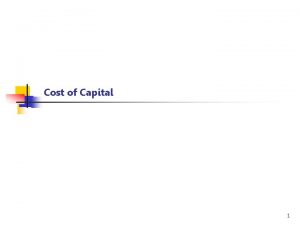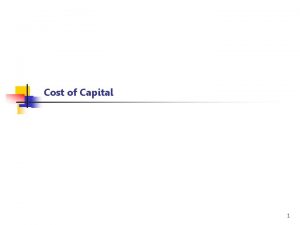Cost of Capital n Rate of return required



















- Slides: 19

Cost of Capital n Rate of return required by firm’s investors ¨ Cost of capital is required rate of return for projects with same level of risk as overall firm ¨ Required rate of return must be adjusted to reflect anticipated risk of project Cost of Capital 1

The Big Picture…. Cost of Capital n Cost of Capital = Average cost of debt and equity ¨ For now, assume ratio of debt to equity constant n As debt increases, required will start to increase at some point Cost of Capital 2

Cost of debt After-tax YTM on debt n Includes flotation costs n Cost of Capital 3

Cost of Debt n Rate of return required by firm’s investors ¨ YTM n (required return) on IBM’s bonds is 10% (Ms. Investor demands a 10% rate of return) ¨ However, IBM’s after-tax cost of debt is 7% Assuming IBM has a 30% tax rate $100 Interest (10%) n - 30 Tax Savings n = 70 After-Tax Interest Cost n Cost of Capital (7%) 4

Cost of Debt n Rate of return required by firm’s investors ¨ Coupon rate on debt is not relevant 12% coupon bond, trading at $1, 117 has a 9% YTM n Would issue additional debt at 9% (before tax) n This would be 6. 3% after-tax (assume 30% tax rate) n Cost of Capital 5

Calculating Required Rate of Return (Yield to Maturity) n Bond has 6. 5% coupon rate, 7 years to maturity and has net price of $870. What is yield to maturity? ¨ Required rate of return (YTM) = 9. 09% ¨ After-tax rate required rate of return = 9. 09% - (38% x 9. 09%) = 5. 64% Cost of Capital 6

Cost of Preferred Stock Cost of preferred stock = annual dividend / net price of preferred stock n Net price is after flotation costs n Cost of Capital 7

Cost of Equity Must be estimated. No stated rate like YTM on bonds or loans. n Calculate cost for both: n ¨ Retained earnings ¨ Issuing new equity Cost of Capital 8

Cost of Equity Dividend Growth Model n NP = D 1 / (RR – G) n RR = (D 1/NP) + G n Calculate cost of retained earnings n ¨ Price (P) , Dividend (D) are known. ¨ Can estimate growth rate (G). ¨ Then solve for required return (RR) n Use Net Price after flotation costs for P Cost of Capital 9

Cost of Equity Dividend Growth Model n NP = D 1 / (RR – G) n RR = (D 1/NP) + G n P = $32, D = $2. 20, G = 4%, NP = $32. 00, D 1 = $2. 29 n RR = ($2. 29/$32. 00)+4% n RR = 11. 15% n Cost of Capital 10

Cost of Equity Dividend Growth Model n Advantage: n ¨ Simple n Issues: ¨ Must estimate growth rate ¨ Some companies don’t pay dividends ¨ Take into account risk? Cost of Capital 11

Cost of Equity Capital Asset Pricing Model (CAPM) n RR = RF + (RM – RF) X Beta n ¨ Risk-free rate of return (RF) is known ¨ Beta is generally known ¨ Required Return for Market (RM) must be estimated Cost of Capital 12

Cost of Equity Capital Asset Pricing Model (CAPM) n RR = RF + (RM – RF) X Beta n ¨ Advantages Adjusts for risk n Can be used for companies with no dividends n Cost of Capital 13

Cost of Equity Capital Asset Pricing Model (CAPM) n RR = RF + (RM – RF) X Beta n ¨ Issues: n Calculating Market Risk Premium (RM – RF) ¨ ¨ ¨ One study: 9. 2% for large cap stocks Another study: 9. 5% for large cap stocks Another study: 4 -6% for large cap stocks Cost of Capital 14

Cost of Equity Bond-yield plus equity risk n RR = YTM + (RM – RF) n ¨ Advantage Uses YTM for company’s bonds as starting point n Can be used to compare with other two methods n Cost of Capital 15

WACC n Market Value Company = Equity Value + Debt Value ¨ Equity n Number of shares x Price of stock ¨ Debt n Value = Market cap Value Number of bonds x Value of Bonds Cost of Capital 16

WACC n WACC = ¨ (Debt Value x Cost of Debt) + ¨ (Equity Value x Cost of Equity) Due to risk premium for equity, generally equity will have a larger cost than debt n But required return on debt will increase if very little equity n Cost of Capital 17

WACC: cost of capital n Debt: usually cheapest after-tax cost ¨ Deduct interest ¨ Barclays 2006 study: n n Investment grade: 4. 0%; high-yield: 5. 6% Preferred stock ¨ Less n Internal equity (retained earnings) ¨ No n risk than common stock flotation costs External equity (issue new stock) ¨ Usually most expensive ¨ Barclays 2006 study: 9% Cost of Capital 18

WACC n n Value of firm maximized when WACC is minimized Should reduce Required Return ¨ This n would increase NPV of projects WACC is not Required Return for all projects ¨ Adjust Required Return based on risk of project ¨ If use WACC for all projects, will accept risky projects and decline safe projects n Since safe projects will generally have low IRR Cost of Capital 19
 Cost of capital required rate of return
Cost of capital required rate of return Required rate of return formula
Required rate of return formula Multinational cost of capital and capital structure
Multinational cost of capital and capital structure Multinational cost of capital and capital structure
Multinational cost of capital and capital structure Return on capital employed
Return on capital employed Capital market line
Capital market line Nature of goodwill
Nature of goodwill Return on invested capital and profitability analysis
Return on invested capital and profitability analysis Igcse business studies formula sheet
Igcse business studies formula sheet Return on capital employed
Return on capital employed How to calculate hpr
How to calculate hpr Real rate of return
Real rate of return Laju pengembalian
Laju pengembalian Calculate arr
Calculate arr How to find internal rate of return
How to find internal rate of return Expected rate of return
Expected rate of return Modified internal rate of return
Modified internal rate of return Ti 83 npv
Ti 83 npv Expected rate of return capm
Expected rate of return capm External rate of return
External rate of return
